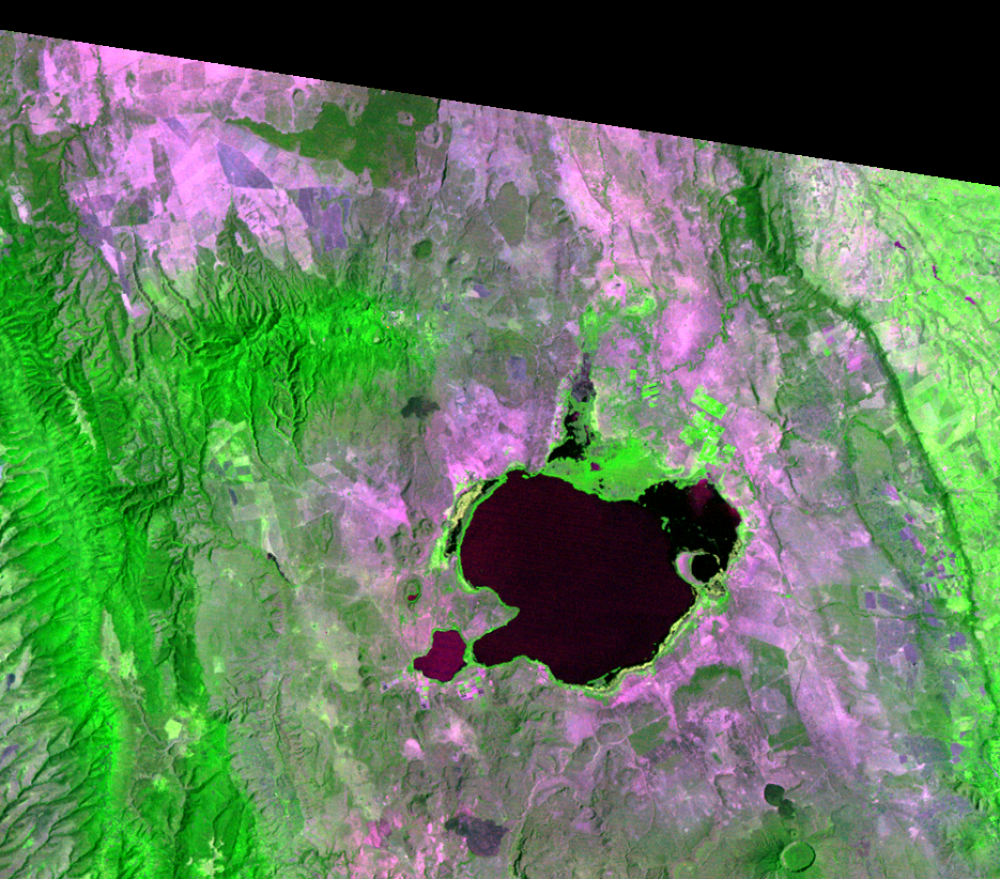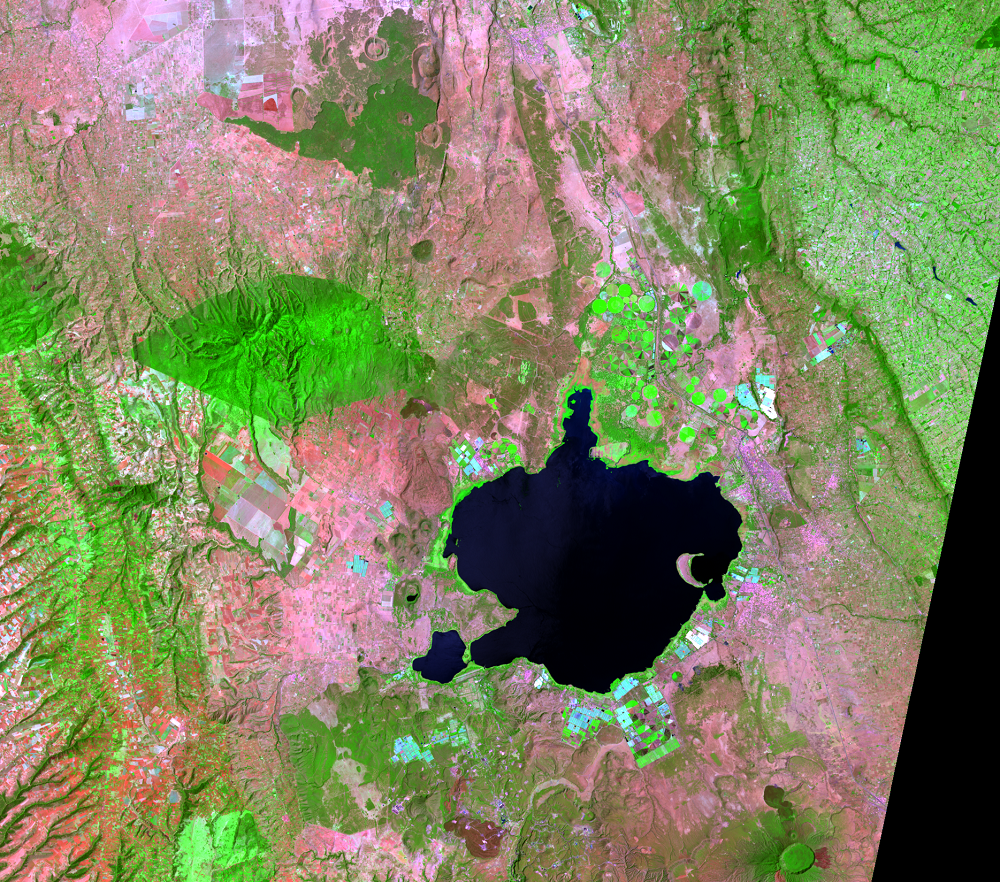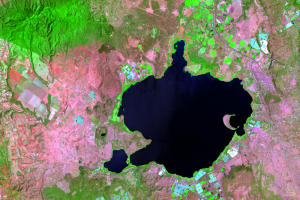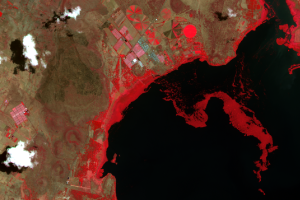
Lake Naivasha, Kenya
Earth Resources Observation and Science (EROS) Center - Earthshots
How do those in northern winter climates get roses to their loved ones in February for Valentine’s Day? The answer is to import them from warmer climates.
Kenya offers the perfect climate for flowers year-round. Its floriculture industry covers land near a shallow lake near the equator. Lake Naivasha is one of the few freshwater lakes in East Africa. Its depth varies from 2 to 8 meters, and the surface area as shown in the 2023 Landsat image is about 150 square km.
Direct rainfall on the lake and three rivers feed freshwater to the lake. The Gilgil and Malewa are perennial rivers, and Karati is a seasonal river. The Malewa contributes up to 90% of the water to the lake. The lake has no surface outlet—it is referred to as an endorheic lake. In most endorheic lakes, salts are left behind when the lake water evaporates. That is, the salts are not washed out through an outlet to another outgoing river. Lake Naivasha, however, maintains its freshwater status because the lake water seeps into the ground, taking the salts with it.
The wetland areas around the Lake Naivasha support not only the large flower industry but also fishing, tourism, and geothermal power. Hundreds of millions of dollars’ worth of cut flowers are exported from Kenya to Europe and other countries. As of 2018, Kenya has 38% of the European Union’s market for cut flowers.
The region offers steady sunlight and days that vary very little in length. Lake Naivasha is not far from Nairobi, Kenya’s capital and largest city, about 90 km away. So transport is relatively easy. The Nairobi airport has a terminal dedicated to transporting flowers and vegetables.
Still, the industry has had challenges. In recent years, workers have been laid off because of lower demand and higher costs. The increase in agriculture has put pressure on the water resources of the area, affecting the water quality of the lake.
Imagery
Downloads
Agutu, P.O., Gachari, M.K., and Mundia, C.N., 2018, An Assessment of the Role of Water Hyacinth in the Water Level Changes of Lake Naivasha Using GIS and Remote Sensing: American Journal of Remote Sensing, v. 6, no. 2, p. 74–88, doi: 10.11648/j.ajrs.20180602.13.
Awange, J.L., Forootan, E., Kusche, J., Kiema, J.B.K., Omondi, P.A., Heck, B., Fleming, K., Ohanya, S.O., and Goncalves, R.M., 2013, Understanding the decline of water storage across the Ramser-Lake Naivasha using satellite-based methods: Advances in Water Resources, v. 60, p. 7–23, https://doi.org/10.1016/j.advwatres.2013.07.002.
Ghansah, B., Harper, D.M., Forkuo, E.K., and Appoh, R., 2016, Using Remote Sensing Techniques For Monitoring Ecological Changes In Lakes—Case Study Of Lake Naivasha: International Journal of Engineering Research and Applications, v. 6, no. 1, p. 1–12.
Kibet, P., and Gitonga, A., 2018, Why Kenyan flower farms is no bed of roses: Standard Digital, accessed Apr. 16, 2019, at https://www.standardmedia.co.ke/article/2001291310/plight-of-kenyan-flower-farm-workers.
Kitunda, J.M., 2018, A History of the Water Hyacinth in Africa: The Flower of Life and Death from 1800 to the Present: Lanham, MD, Lexington Books, 336p.
Mironga, J.M., Mathooko, J.M. and Onywere, S.M., 2014, Effects of spreading patterns of water hyacinth (Eichhornia crassipes) on zooplankton population in Lake Naivasha, Kenya: International Journal of Development and Sustainability, v. 3, no. 10, p. 1971–1987.
Morgan, S., 2018, Europe’s love of roses sends ripples through Kenyan lake: Euractiv, accessed Apr. 16, 2019, at https://www.euractiv.com/section/africa/news/europes-love-of-roses-sends-ripples-through-kenyan-lake/.
Murage, G., [n.d.], Oserian flower farm to lay off 400 employees: Flowerweb, accessed Apr. 16, 2019, at https://www.flowerweb.com/en/article/194473/Oserian-flower-farm-to-lay-off-400-employees.
Murage, G., 2018, Hyacinth in Lake Naivasha hurting fishing and tourism: The Star, accessed Apr. 4, 2019, at https://www.the-star.co.ke/news/2018-12-13-hyacinth-in-lake-naivasha-hurting-fishing-and-tourism/.
Onywere, S.M., Mironga, J.M., and Simiyu, I., 2012, Use of Remote Sensing Data in Evaluating the Extent of Anthropogenic Activities and their Impact on Lake Naivasha, Kenya: The Open Environmental Engineering Journal, v. 5, p. 9–18.
Ramsar, 2005, Lake Naivasha: Ramsar Sites Information Service, accessed Apr. 4, 2019, at https://rsis.ramsar.org/ris/724.
Riebeek, H., 2008, Lake Naivasha, Kenya: NASA Earth Observatory, accessed Apr. 4, 2019, at https://earthobservatory.nasa.gov/images/8599/lake-naivasha-kenya.
Veselinovic, M., 2015, Got roses this Valentine's Day? They probably came from Kenya: CNN, accessed Apr. 16, 2019, at https://www.cnn.com/2015/03/16/africa/kenya-flower-industry/index.html.
Waithaka, E., 2013, Impacts of Water Hyacinth (Eichhornia crassipes) on the Fishing Communities of Lake Naivasha, Kenya: Journal of Biodiversity & Endangered Species, doi: 10.4172/2332-2543.1000108.
Walton, B., 2010, Blooming Controversy—What Is Killing the Wildlife in Kenya’s Lake Naivasha? Circle of Blue, accessed Apr. 4, 2019, at https://www.circleofblue.org/2010/world/blooming-controversy-what-is-killing-the-wildlife-in-kenya%E2%80%99s-lake-naivasha/.




